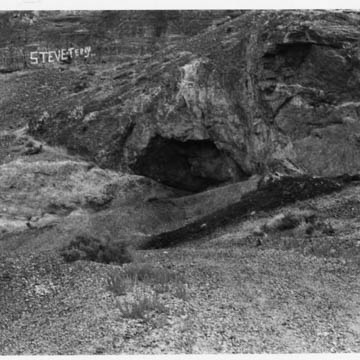Danger Cave, the largest ancient cave in Wendover, yields information about some of the earliest inhabitants of the Great Basin. Archaeologist Jesse D. Jennings, who excavated the cave in the 1950s and has written extensively about his findings, discovered signs of human habitation in the cave dating back to 8000 BCE.
The cave is a long, arched grotto or cavern averaging 60 feet wide and 120 feet long. It has no natural chimneys; the only source for the circulation of air and light is the mouth of the cave, which features a thick overhang. Not surprisingly, most of the signs of occupation are found near the front third of the cave. Archaeologists estimate that at any given time no more than 15 to 30 individuals, probably related to one another, occupied the site. These people were nomadic and the cave was a seasonal abode used only during the late summer and early autumn months. The climate, the landscape, and the resources—the entire ecological system—throughout most of the history of the cave were identical with those of today, even though conditions of aridity may have fluctuated noticeably.
Archaeologists began digging the site first in the 1930s, and then more extensively in the 1950s under Jennings’s University of Utah team. Fill materials (dust, dirt, weeds, and other sources of debris) found at the site were the remains of both human habitation and geological transformations (e.g., silt from the lake that is now below the floor level of the cave). The combination has been critical for understanding the chronology of the long chain of recent geologic events. Located about 4,325 feet above sea level, Danger Cave has the lowest elevation of all the archaeologically significant caves in Wendover. Since the level of Wendover dropped after the last glacial era, this cave provides us with the earliest date that caves were available for human habitation.
The dryness of the cave was desirable for dwelling and excellent for the preservation of all types of organic debris. The chief vegetable foods for the inhabitants appear to have been seeds and rhizomes. Game of all types seems to have been available and was hunted in a number of different ways with an impressive array of tools. In terms of artifacts, the site has yielded the largest number in Utah and demonstrates a material culture characterized by portability. The oldest recovered specimens that are of archaeological significance are 10,000 years old and include basketry, string, fragile food bones and bone tools, human and animal fecal matter, feather, bits of leather and rawhide, grass seeds, and thousands of stone artifacts. These artifacts show incredible site specificity and accommodation to the environment; they also demonstrate a strategic exploitation of every resource the desert offered. Most are utilitarian and don’t demonstrate much attention to ornamentation—arrow shafts, for example, only occasionally have red and green decoration. The scraps of garments that have been discovered are made of buckskin but are not fringed.
These seasonal cave dwellers were expert textile makers and basket weavers, and archaeologists have uncovered fourteen different basketry techniques. Six use twining and the remaining eight deploy variations of the coiling technique. Without exception, this basketry was well executed and sturdy.
The site was declared a National Historic Landmark in 1961 and was listed on the National Register of Historic Places in 1966. Today the area around it, the Danger Cave State Historic Monument, is one of the forty-five state parks in Utah. It is protected and monitored by the State Park Services. The landmark is open to the public only with a designated guide. A set of metal gates, installed to reduce vandalism, allows one to peek in without entering.
References
Fry, Gary Frederic. “Prehistoric Diet at Danger Cave, Utah, as Determined by the Analysis of Coprolites.” Master’s thesis, University of Utah, 1968.
Jennings, Jesse D. Danger Cave. Salt Lake City: University of Utah Press and Society for American Archeology, 1957.










